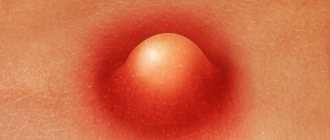Bronchial obstruction is not a diagnosis, but a syndrome: a pathological condition in which the lumen of the bronchi narrows significantly and air cannot pass through them in sufficient quantities. The attack of suffocation caused by it frightens the patient and looks frightening from the outside - the person can neither exhale nor inhale, turns blue, breaks into a dry cough that does not bring relief, tensely, with a whistle, squeezes out tiny portions of air. Moreover, when this happens to a child, relatives panic.
This syndrome is also a form of respiratory failure. So what can cause bronchial obstruction syndrome (BOS) and what to do in this case?
general information
Bronchial obstruction syndrome is a pathological process in which there is a narrowing of the lumen of the bronchi, their inflammation and the release of a large amount of viscous sputum.
This condition is not inherent to a specific disease. This is a symptom that reflects that there are certain problems in the human body, and not necessarily from the respiratory system.
A dangerous spasm can occur at any age, but the most severe course is observed in children and the elderly.
In most cases, diagnosing obstructive disease is not difficult, but the cause cannot always be determined quickly.
The pathology tends to be severe. If assistance is not provided in a timely manner, it can lead to death due to suffocation. Long-term progression is fraught with the development of pathologies of the cardiovascular system.
Complications
With untimely, incomplete or poor quality treatment of broncho-obstructive syndrome, the following complications most often occur:
- Dangerous heart problems;
- Heart failure;
- Paralytic state of the respiratory center;
- With frequent asthma attacks - secondary emphysema;
- Pneumothorax;
- Pulmonary atelectasis;
- Choking (asphyxia);
- Formation of acute pulmonary heart.
Why does the violation occur?
Factors that cause inflammation of the bronchial mucosa include:
- action of allergens;
- penetration of pathogenic microorganisms;
- bad environment;
- radiation;
- work in hazardous industries;
- bad habits;
- insufficient air humidity.
There are a lot of diseases accompanied by complaints of difficulty breathing. The most common include:
- various bronchitis (acute, chronic, obstructive);
- ulcerative lesions of the gastric mucosa;
- pneumonia of any etiology;
- congenital respiratory defects;
- the presence of mechanical barriers (tumors, cysts);
- tuberculosis;
- cystic fibrosis;
- pulmonary emphysema;
- bronchial dysplasia;
- AIDS;
- pathologies of the cardiovascular system;
- spinal hernia;
- damage to the nervous system;
- brain tumors;
- invasive infections;
- rickets.
Everything in the body is connected, and a disruption in the functioning of one organ will certainly lead to the development of secondary pathological processes, so any disease must be treated without causing complications.
Causes of bronchial obstruction
Bronchial obstruction can accompany many pathological conditions. To treat it, it is necessary to take into account the reasons that led to the obstruction. This:
- Allergic reactions.
- Entry of foreign objects or vomit into the respiratory tract.
- Pneumonia.
- Bronchitis, especially chronic.
- Bronchial asthma.
- ARVI (in particular, infection with respiratory syncytial virus).
- Stagnation of fluid in the lungs due to vascular and heart diseases (acquired or congenital).
- Tumors in the respiratory system.
- Inhalation of toxic gases.
- Working in a dusty room.
- Cystic fibrosis.
- Tuberculosis.
How to recognize danger signs?
Symptoms of bronchial obstruction syndrome directly depend on the form in which it occurs. She may be:
- Easy.
- Average.
- Heavy.
Classic signs include:
- Feeling of lack of air.
- Heaviness when exhaling and inhaling.
- Shortness of breath.
- Blue discoloration of the nasolabial triangle.
- Expansion of the chest.
- Swelling of the neck veins.
- Loss of consciousness.
To prevent death, such patients require emergency medical care.
In mild cases, the patient may not even be aware of the presence of dangerous changes in the structure of the bronchial tree. Often, the pathology is diagnosed accidentally, during routine fluorography or x-rays (in the presence of acute respiratory infections or suspected pneumonia).
Persons who have relatives suffering from bronchospasm should know how to behave when the next attack begins.
Symptoms of bronchitis with obstructive syndrome
Broncho-obstructive syndrome is characterized by symptoms that make it possible to quickly identify problems with the bronchi.
Bronchial obstruction has the following symptoms:
- Dyspnea;
- wheezing;
- Unproductive cough;
- Cyanosis of mucous membranes and skin;
- Weight loss;
- Changing the shape of the chest;
- Use of accessory muscles during breathing.
Obstructive syndrome is a dangerous condition, as if not properly treated it can cause complications.
Course of the disease in children
Bronchial obstruction syndrome can occur in infants or older children. The pathological condition is accompanied by:
- severe cough;
- difficulty breathing;
- whistling, mainly when exhaling.
Most often it occurs:
- as a reaction to an allergen (food or inhaled);
- for acute respiratory infections, acute respiratory viral infections or influenza.
Less common are congenital malformations of the bronchopulmonary system.
If there are no such anomalies, then in the initial stages, spasms of the respiratory system can be successfully treated. Advanced forms cause irreversible changes in the bronchial tree, and the pathology becomes chronic.
As it progresses, the child develops:
- periodic attacks of suffocation;
- cyanosis of the skin;
- dark circles under the eyes;
- swelling of the neck veins.
Such conditions are extremely dangerous. If assistance is not provided in a timely manner, the child may suffocate.
Urgent Care
Bronchial obstruction is an emergency condition. When it appears, patients usually call the emergency room. Before the ambulance arrives, you need to take the following measures:
- ventilate the room;
- calm down;
- if shortness of breath does not appear for the first time, you need to take the medications that were used before;
- use a nebulizer if available.
Arriving doctors will inject aminophylline into a vein. If necessary, prednisolone will be added. If the measures taken do not work, the patient is taken to the hospital.
It is important to understand that only a doctor deals with the treatment of bronchial obstruction. Self-medication, attempts to use folk remedies, and failure to seek medical help in a timely manner can lead to irreversible changes and the ineffectiveness of all medications.
Bronchospasm during pregnancy
In some women, bronchial obstruction syndrome is diagnosed for the first time during pregnancy. This is due to various changes in the body. Hormonal levels change, immunity decreases.
These are favorable conditions for the penetration of infections that cause long-term inflammation of the respiratory system, and as a result, obstructive disease.
The problem is complicated by the narrow range of drugs allowed during pregnancy. The issue of treatment of bronchial obstruction syndrome in this case is decided individually. Medications prohibited for expectant mothers may be prescribed if there is a real threat to the woman’s life.
If you are prone to allergies, antihistamines will definitely be prescribed, since this factor plays an important role in the development of bronchospasm.
Those who have previously experienced bronchial obstruction may notice an increase or decrease in the frequency of attacks or their complete disappearance.
Independent selection of medications is strictly prohibited. This may negatively affect the health of the mother or child.
Treatment of the disease
Any therapy is aimed primarily at eliminating the cause of biofeedback, but it is necessary to alleviate the symptoms of this syndrome.
Treatment includes several main areas, such as bronchodilator and anti-inflammatory therapy, as well as therapy aimed at improving the drainage activity of the bronchi
Doctors prescribe the following clinical recommendations for broncho-obstructive syndrome:
Mucolytic therapy. This is the use of drugs that dilute sputum and facilitate its easy removal - Ambroxol, Bromhexine, Acetylcysteine.
- Rehydration. To thin the mucus and for the medications to work, you need to drink enough fluids throughout the day. It is desirable that it be mineral water - Essentuki, Borjomi, Polyana Kvasova.
- Massage. A light therapeutic massage of the chest and back helps improve blood circulation, saturate the blood with oxygen, and facilitate the removal of phlegm.
- Therapeutic breathing.
- If the cough is allergic in nature, take antiallergic drugs - Erius, Claritin, Suprastin, Loratadine.
- For a non-productive dry cough that debilitates the patient, it is recommended to take codeine-containing drugs or medications that block the cough center in the brain - Codesan, Cofex, Libexin, Glauvent.
- If it is difficult to discharge sputum, expectorant medications are used - plant-based syrups (Plantain, Licorice, Ivy).
- Agents used to dilate the bronchi are Aerophylline, Neophylline, Theophylline.
Diagnostics
If alarming symptoms appear, you should definitely consult a doctor. Such pathologies are treated by:
- Pulmonologists.
- Allergists.
Making the correct diagnosis will not be difficult. Upon initial contact, the specialist:
- collect all the necessary information;
- will carry out an inspection;
- will provide direction for the necessary research.
A plain x-ray will reveal the obstruction. To determine its cause, the following laboratory tests will be required:
- general and biochemical blood tests;
- sputum culture;
- allergy tests;
- scraping for helminths or PCR diagnostics.
During the examination, the list may be supplemented with other methods at the discretion of the doctor.
First aid
Most often, an attack of suffocation occurs at night. If this happens for the first time, you must definitely call an ambulance.
Before doctors arrive, you should:
- Try to eliminate the allergen that provoked the pathological condition. This could be medications, dust, pollen, or pet hair.
- Rinse the patient's mouth and nose to partially eliminate the irritant from the mucous membranes.
- Place the person on the bed (do not lay him down). Free your chest from tight clothing.
- Open the window for fresh air.
- If the condition is rapidly deteriorating, and there are still no doctors, you need to use any bronchodilator, for example, a can of Ventolin.
It is strictly not allowed:
- rubbing the patient with balms, honey, vinegar;
- self-administration of medications, especially antitussives;
- placing the patient in a horizontal position.
During the initial attack, hospitalization will be recommended for the person, especially if we are talking about a child under 3 years old. You should not refuse, because after receiving the necessary help, the attack often repeats.
If bronchospasm has occurred previously, the patient’s relatives should always have an aerosol with salbutamol or another medicine prescribed by the doctor on hand.
When breathing function is restored, there is no need to call an ambulance, but you should visit a doctor as soon as possible. If the medicine does not help, then emergency help will still be required.
Help during a seizure
- It is necessary to stop (stop) the attack of suffocation as soon as possible.
- If the cause is a foreign body, measures are taken to remove it.
- If bronchial obstruction syndrome is of an allergic nature, the significant allergen should be eliminated if possible.
The spasm itself is relieved with short-acting bronchodilators in the form of inhalations. For this use:
- salbutamol (Ventolin);
- fenoterol (Berotec);
- ipratropium bromide (Atrovent);
- budesonide (“Pulmicort”);
- combination drugs (“Berodual”).
- They also use adrenaline, Hydrocortisone or Prednisolone, and give oxygen.
After the end of the acute attack, the doctor will prescribe further therapy in accordance with the nature of the bronchial obstruction.
Drug treatment
Symptoms of bronchospasm in adults should be treated as quickly as possible.
The basis of successful therapy is the elimination of provoking factors. For this the following can be used:
- antibiotics;
- antiviral agents;
- antihistamines;
- antacids;
- tranquilizers;
- neuroleptics;
- antiparasitic medications.
Direct elimination of bronchospasm is carried out:
- "Ventolin";
- "Berodual";
- Teopecom;
- "Eufillin".
To improve respiratory function, therapy is supplemented with:
- mucolytic agents (“Ambroxol”, “Acetylcysteine”);
- glucocorticoids (“Prednisolone”, “Pulmicort”).
The dosage is selected individually, taking into account the health status and age of the patient.
Any aerosol with salbutamol is considered the best way to relieve an attack at home.
Treatment of broncho-obstructive syndrome
Treatment includes a number of main directions, such as anti-inflammatory, bronchodilator therapy, pharmacotherapy and therapy for improving the drainage function of the bronchi.
To improve the efficiency of the drainage system, it is important to carry out the following procedures:
- Mucolytic therapy;
- Massage;
- Rehydration;
- Breathing therapeutic exercises;
- Postural drainage.
Optimal body position for postural drainage
The goal of mucolytic therapy is to thin sputum and increase cough productivity.
When mucolytic therapy, factors such as the patient’s age, amount of sputum, severity, etc. are taken into account.
If the child has sticky sputum and an ineffective cough, inhaled and oral mucolytics are usually prescribed. The most popular of them: Lazolvan, Ambrobene, etc.
It is acceptable to use mucolytic drugs in combination with expectorants. They are often prescribed to children with a dry cough that does not go away for a long time.
Folk remedies also have a good effect - a decoction of coltsfoot, plantain syrup, etc. If a child is diagnosed with a moderate degree of the syndrome, he may be prescribed acetylcysteine; in severe forms, it is not recommended to take mucolytic drugs on the first day.
Bronchodilator therapy
In children, bronchodilator therapy includes anticholinergics, theophylline, and short-acting beta-2 antagonists.
Beta-2 antagonists have a rapid effect when taken via nebulizer. Among these drugs are Salbutamol , Fenoterol, etc. These drugs should be taken 3 times a day. They have side effects, however, with prolonged use of beta-2 antagonists, a decrease in therapeutic effect is observed.
Among theophylline preparations, one can highlight, first of all, Euphyllin, which is intended primarily to prevent the development of bronchial obstruction in children.
Eufillin has positive and negative qualities. The advantages of this product are quick results, low cost, and simple application. Disadvantages include numerous side effects.
Anticholinergics are drugs that block M3 receptors. Among them, Atrovent stands out, which is best taken from 8 to 20 drops 3 times a day through a nebulizer.
Anti-inflammatory therapy
The goal of this therapy is to suppress the inflammatory process in the bronchi. Among the drugs in this category, Erespal can be distinguished.
In addition to relieving inflammation, Erespal can reduce obstruction in children, as well as control the volume of mucus secreted. This remedy gives an excellent effect at the initial stage. Suitable for use by young children.
In severe biofeedback, inflammation is relieved with the help of glucocorticoids. The inhalation method of administration is preferable - the effect occurs fairly quickly. Among glucocorticoids, the most popular is Pulmicort.
If a patient is diagnosed with allergic ailments, he is prescribed antihistamines. The patient is prescribed antibiotics as antiviral and antibacterial therapy. If the patient experiences great difficulty breathing, he is prescribed oxygen therapy through a special mask or nasal catheters.
Surgery
In especially severe cases, surgical procedures are resorted to. Such treatment is required for bronchospasms caused by mechanical obstacles, such as:
- benign and malignant tumors;
- adhesions;
- congenital defects of the bronchi and lungs.
The operation is carried out using several methods:
- Eliminate neoplasm.
- The lung or part of it is cut off.
- An organ is transplanted.
If bronchospastic syndrome is provoked by cancer, then an oncologist is involved in the treatment, who will monitor the process and select a further regimen.
Physiotherapy
How to get rid of phlegm in the bronchi? This question worries many patients. Doctors often prefer an integrated approach to eliminating this problem and prescribe to patients:
- UHF;
- drainage;
- warming up;
- inhalation;
- rehydration.
Their main advantage is the almost complete absence of contraindications. Such physiotherapy can be performed on young children, pregnant and lactating women.
Doctors recommend that all patients suffering from airway obstruction purchase a modern inhalation device - a nebulizer. It operates on the principle of splitting the drug into small particles using a built-in compressor. Thanks to this, the drug easily reaches the most inaccessible areas of the bronchus.
In pharmacies you can purchase ready-made solutions for this device based on salbutamol, ambroxol, fenoterol.
Regular inhalations with saline solution or Borjomi mineral water have a beneficial effect on the respiratory system.
Treatment
Therapy of bronchial obstruction begins with an impact on the underlying disease that caused the development of this condition. In case of an infectious process (which often happens), the patient must take antiviral or antibacterial medications. In combination with them, antihistamines and infusion solutions are prescribed for intoxication. If there is swelling or congestion in the lungs, then diuretics are added.
To thin thick sputum, expectorants are used: ambroxol, lazolvan, bromhexine and others. Sometimes it becomes necessary to wash the bronchi. This allows you to remove mucus that the patient cannot cough up. This procedure is performed using a bronchoscope. In this case, the patient is under general anesthesia.
To relieve suffocation, sympathomimetics with a short effect are used: salbutamol, ventolin, berotec, berodual or atrovent. They are inhaled using special devices: a nebulizer or a pocket inhaler. When they do not help, aminophylline and hormonal agents such as dexamethasone, hydrocortisone, and prednisolone are administered intravenously. Next, long-acting sympathomimetics (Serevent) are prescribed for continuous use.
When an object enters the respiratory tract, it is removed using a bronchoscope.
Gymnastics
The outflow of viscous sputum can be improved through special exercises. The most commonly used set of Strelnikov exercises is:
- In a standing position, slightly tilt the body forward, taking a deep breath through the nose, after which they raise the torso and exhale freely through the mouth. After 8 approaches they try to clear their throat.
- In the same position, the arms are bent at the elbows. When inhaling, they cross, and when exhaling, they return to their original position.
Breathing exercises are no less effective; they involve taking deep breaths through the nose and exhaling while changing body position.
For example, when lying on a bed, they turn over on one side. They make several approaches and clear their throat. Repeat on the other side, on the stomach, back.
Any physical activity allows you to better remove phlegm.
You can offer the child a game. He lies down on the bed or sofa so that his body hangs slightly down, then he is asked to sing a funny song. At this moment, the parent lightly taps the baby’s back. As a result, vibrations appear that promote the sticking of the viscous substance from the lumen of the bronchi.
It is recommended to do any gymnastics to improve the outflow of sputum for no more than 5 minutes. People who regularly suffer from respiratory diseases are advised to do a daily set of exercises.
Doctors have proven that you should always inhale air through your nose. This not only helps eliminate stagnation, but also has a positive effect on the body as a whole.
Algorithm for parents to act upon obstruction
Help for children under 1 year old.
- Place the child on your knees so that his face is facing the floor, his head is below the lumbar spine.
- Then make strong (within reason) claps between the shoulder blades on your back.
- After this, if the child continues to choke, you need to put him on a flat surface, tilt his head back, and press quite firmly on the area above the navel. This is 3-4 centimeters above the navel.
Help for children over one year old.
- The child should be placed with his back, leaned against him.
- Get down on your knees from behind.
- At the level of the solar plexus (the area above the navel), grab the baby and clasp your hands in front.
- Make several shocks, quite strong, the interval between them is 1 minute. And wait for the ambulance to arrive.
Alternative Methods
Before getting rid of phlegm in the bronchi, it is necessary to find out the cause of the problem, but many people often neglect this advice, continuing to conduct experiments on their health.
Most often, folk remedies are used based on the collection of expectorant herbs and honey, which are included in the list of the strongest allergens.
For bronchospasm, such treatment is prohibited, because it often only worsens the condition.
People often consider the science of treating “like with like” to be a panacea for all diseases.
Representatives of classical medicine are against homeopathic treatment because they consider it ineffective, which was officially proven at the beginning of 2021.
The positive effect of “magic peas” is nothing more than a placebo. They actually treat some diseases based on self-hypnosis. These include various depressions, neuroses, and hypochondria.
In the case of an obstructive condition, there is a serious functional impairment that threatens life, so the use of homeopathy is unacceptable.
Treatment of symptoms of bronchospasm in adults must be carried out immediately, and the use of such drugs leads to the transition of the underlying disease into a chronic form, deterioration of the condition, or even death.
Features of pathology9
Broncho-obstructive syndrome is not an independent disease; this pathology occurs as a result of certain diseases and is a whole complex of symptoms that worsen a person’s life. It occurs as a result of deterioration in the passage of air masses through the bronchial tree. It is believed that broncho-obstructive syndrome is mostly a childhood disease. After all, it is diagnosed in 35-45% of children, especially under the age of 3 years, but it also happens in adults.
Prognosis for recovery depends directly on the primary cause of the syndrome. In some cases, bronchial obstruction is completely curable, in others it leads to irreversible consequences.
Broncho-obstructive syndrome (BOS) is a complex of symptoms of organic origin, characterized by various disorders in the functioning of the respiratory system
Prevention and prognosis
Every year, bronchospastic syndrome is diagnosed more and more often and can occur in anyone. To minimize this risk, you must:
- quit smoking;
- do not use electronic cigarettes;
- if possible, move to live closer to the sea;
- refuse the abundance of scented household chemicals;
- monitor your health, if you have allergy symptoms, get tested and identify potentially dangerous substances;
- strengthen your immunity (move more, toughen up, adjust your diet);
- avoid stress, get good sleep;
- if you have complaints, consult a doctor, avoid chronic processes;
- Do breathing exercises daily.
Bronchial obstruction syndrome should not be taken lightly. This is a truly dangerous symptom that can take a person’s life in a few minutes. At the first signs of breathing problems, you should visit a specialist and undergo an examination. In acute cases, call an ambulance. In the early stages, most obstructions are well treated. Therefore, you should not postpone the problem until later.










